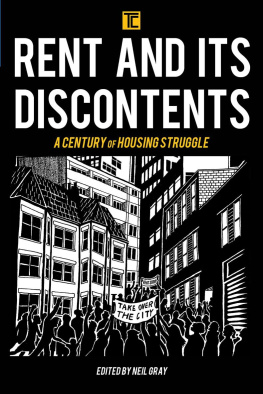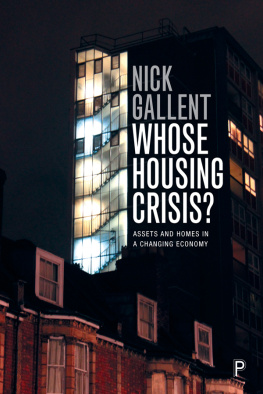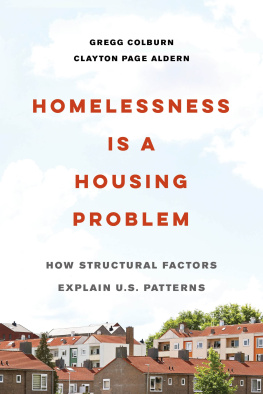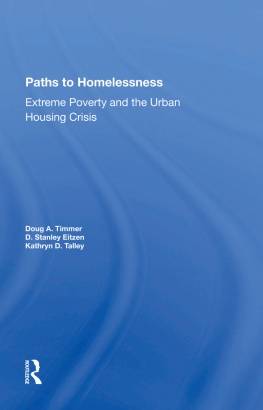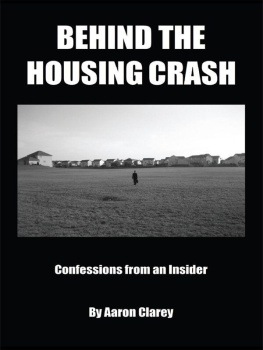About the author
Deborah Potts is an Emeritus Reader in Human Geography at Kings College London. She has written and researched extensively on issues around urbanization, migration, livelihoods and housing, with a particular focus on urban Africa. Her previous books include African Urban Economies: Viability, Vitality or Vitiation? ( 2006 ) and Circular Migration in Zimbabwe and Contemporary Sub-Saharan Africa ( 2010 ).
Broken Cities
Inside the Global Housing Crisis
Deborah Potts
Broken Cities: Inside the Global Housing Crisis was first published in 2020 by Zed Books Ltd, The Foundry, Oval Way, London SE RR, UK.
www.zedbooks.net
Copyright Deborah Potts 2020
The right of Deborah Potts to be identified as the author of this work has been asserted by her in accordance with the Copyright, Designs and Patents Act 1988 .
Typeset in Akzidenz Grotesk and Haarlemmer by Swales & Willis Ltd, Exeter, Devon
Cover design by Kika Sroka-Miller
Cover photo David Rose; Panos Pictures
Printed and bound by CPI Group (UK) Ltd, Croydon, CR YY
All rights reserved. No part of this publication may be reproduced, stored in a retrieval system or transmitted in any form or by any means, electronic, mechanical, photocopying or otherwise, without the prior permission of Zed Books Ltd.
A catalogue record for this book is available from the British Library
ISBN -- 78699 -- hb
ISBN -- 78699 -- pb
ISBN -- 78699 -- pdf
ISBN -- 78699 -- epub
ISBN -- 78699 -- mobi
Contents
In 1978 , shortly before the era of neoliberal capitalism was imposed on urban societies across much of the world, I began researching urban processes and livelihoods in southern Africa. Over the decades I researched and taught about urban livelihoods, low-income housing, the changing characteristics of migrant households and of migration patterns both to and from cities, and the role and nature of so-called informality in employment and housing. In particular, I spent much time and conducted major surveys in low-income neighbourhoods in Harare, the capital city of Zimbabwe. Along with the surrounding countries of Malawi, Zambia and South Africa, almost every type of low-income housing policy in fashion for the cities of the Global South from the late 1970 s to today were practised with varying results. Most were promoted as affordable; very few were. Zimbabwe and South Africa were both ruled by white minorities when I began my academic career. This meant that they also had, most unusually for sub-Saharan Africa, significant provision of public rental housing that was affordable in so-called townships, although its main original purpose was for political control of migration and black African urban residents.
In the UK, I live in the borough of Haringey in north-east London. I moved there in the late 1970 s at a time when the issue of housing affordability per se in the UK had largely been solved by the cumulative outcomes of state intervention over many decades, but particularly since the end of the Second World War. The ward in which I live is culturally diverse and constantly changing. Haringey has some very wealthy residential areas, some much poorer areas, and everything in between a comprehensive range of the various private- and public-sector housing types to be found in London outside the citys central (and ludicrously expensive) areas. As with many of Londons residential boroughs beyond its historic centre, Haringeys phases of rapid development in the late nineteenth century, from a peri-urban mix of land uses, including agriculture, to a densely built urban housing environment, followed the geography of the new underground railway lines. I have rented in the private sector in Haringey (and elsewhere in London), experiencing the usual range of eccentric and sometimes venal landlords, dangerous exploding water heaters and bizarre fungi and moulds that renters may encounter in that sector in the UK, albeit at a time when the rents were affordable. In the early 1980 s, just as the first round of massive upswings in London house prices began, I bought a dilapidated terraced house. This had been divided into five bedsits by the previous owner and did not comply with most of the statutory housing standards. Today, it is worth a fortune because of subsequent rounds of surges in house prices in the UKs cities, and particularly in London. It is utterly unaffordable to the sorts of households who were buying in the area in the 1980 s. Their typical employment and related income profiles, and reliance entirely on mortgages and % cash deposits, would not buy a house in Haringey today.
Over the decades, my lived experience in north London and various cities in southern Africa, alongside my research and teaching on housing, increasingly led me to see the issues underlying housing outcomes and the issue of affordability in these areas, and elsewhere in the urban world, in terms of their structural similarities rather than their differences, albeit always shaped by specific local histories and politics. The crisis of housing affordability across the worlds major cities has also deepened and become more embedded. These are the issues that led to this book. In the following chapters examples are drawn from across the world but particularly from southern Africa and from London. A deliberate effort is made to illustrate problems and policies with reference to cities outside Europe and North America.
Generation Rent in London and divided families in South Africa; dormitory living in Shenzhen and the favelas of Rio de Janeiro; squatters on the edge of Lisbon and cage housing in Hong Kong. What do these situations have in common? The answer is obviously that they are urban housing problems. But can they be understood as manifestations of the same underlying urban processes?
Much work by scholars and policymakers argues that the common problem is to do with a shortage of housing, sometimes linked to shortages of urban land for residential housing. This conceptualises lack of housing in cities across the world as a supply-side problem the obstacles to the provision of housing for all are constraints on supply. If enough houses were built, prices would fall into line with demand: the magic of the market, of the invisible hand, would provide the solution.
The key argument of this book is that that approach looks at the housing crisis which is manifest across the urban world, and most particularly in the largest cities, where economic opportunities are apparently greatest from the wrong end of the telescope. The real problem is demand. This sounds strange, perhaps, since evidently nearly everyone wants a home a place of shelter and privacy, a place for family life and socialising. But that is not demand in the sense that much contemporary policy across the world can currently handle. Instead, demand must be expressed in terms of money. So while it is universally accepted that people need housing, they can only live in what they can afford. Some discussions about housing demand can be meaningless. One set of protagonists may be expressing their arguments with reference to the norms of modern urban societies, whereby demand for housing is basically expressed in neoclassical orthodox economic terms (prices). Others may instead be referring to evidently expressed needs or wants, which, confusingly, can also be termed demand. It helps when it is recognised that housing is not that different from other basic needs, such as food. Obviously, for example, there is no shortage of food in Britain, but, as has become increasingly the case since the financial crisis of 2008 , many people even in that country cannot afford enough food. No one argues that this is a supply-side issue. Thus, there is a housing dilemma. This term, which is central to the arguments developed in this book, relates to the problem that housing demands from some income groups can be met by the market but that housing needs from many in poorer groups cannot.


